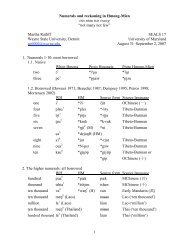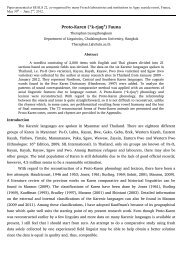proto-southwestern-tai revised: a new reconstruction - seals 22
proto-southwestern-tai revised: a new reconstruction - seals 22
proto-southwestern-tai revised: a new reconstruction - seals 22
You also want an ePaper? Increase the reach of your titles
YUMPU automatically turns print PDFs into web optimized ePapers that Google loves.
4 Marc Brunelle<br />
the speech of some speakers, as summarized in (3), have led a number of authors to claim<br />
that this language is either tonal or incipiently tonal.<br />
(3) An example of a description of the pitch allophones of the two registers in Eastern<br />
Cham (Phú et al. 1992)<br />
pa high pitch ‘to cross’<br />
pa� high pitch ‘four’<br />
p�a low pitch, breathy ‘to carry’<br />
p�a� low rising pitch, breathy ‘to wander (rare)’<br />
However, what different authors mean by “tone” is highly variable. The first modern<br />
descriptions often designated the register allophones as ‘tones’ or ‘pitches’ without<br />
claiming that they were phonemic (Blood 1967; Moussay 1971; Hoàng 1987). These<br />
authors recognized (sometimes implicitly) that there were only two distinctive registers<br />
contrasting in pitch, but that each of them had predictable variants conditioned by codas.<br />
Another group of authors has more recently adopted the view that the codas are either lost,<br />
in the process of being dropped, or reinterpreted as tonal elements, which comes down to<br />
claiming that the register allophones have become contrastive tones (Phú et al. 1992;<br />
Thurgood 1993; 1996; 1999). We have since gathered evidence that codas are still present<br />
and that although they are partly debuccalized, they preserve their patterns of contrast and<br />
show no sign of deletion (Brunelle 2005b; 2006). Moreover, the pitch curves of codaconditioned<br />
register allophones vary across speakers, making them unlikely contrastive<br />
elements (Brunelle 2005b; 2006). Finally, evidence from reduplication and a word game<br />
strongly suggests that register can be phonologically analysed as a segmental property of<br />
onset consonants (Brunelle 2005a; b). Until we have additional phonological evidence, and<br />
despite the central role of pitch in its register contrast and the fact that all the basic<br />
ingredients needed for tonogenesis are present, we must conclude that there is at the<br />
moment no evidence that the dialects of Eastern Cham that have been studied so far have<br />
phonemic tone or are incipiently tonal.<br />
1.2.2 Western Cham (Châu Đốc)<br />
There is only one description of register in a dialect of Western Cham spoken in Vietnam<br />
(Friberg and Hor 1977) 4 . Impressionistically, this dialect, spoken in Châu Đốc, seems<br />
similar to the Western Cham dialects spoken elsewhere in Vietnam (in Tây Ninh and in a<br />
small settlement near Xuân Lộc, in Đồng Nai province).<br />
In this description, Friberg and Hor followed Gregerson (1973) in claiming that<br />
tongue root position is responsible for the register contrast in the dialect that they studied.<br />
They hypothesized that all low register consonants are produced with an advanced tongue<br />
root [+TRA], while other consonants are produced with a neutral tongue root position.<br />
Since the claim that the tongue-root is the main articulator involved in register production<br />
has since been abandoned, we will not discuss the technicalities of Friberg and Hor’s<br />
featural analysis. However, their acoustic description of the effect of register on the vowels<br />
4<br />
Friberg and Hor are not explicitly saying that they investigated the Châu Đốc dialect. This information in<br />
mentioned in Headley (1991).





